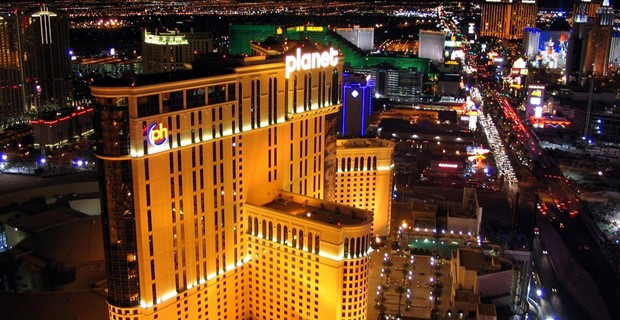 |
| Editor’s note: The image above is a photograph of the Planet Hollywood casino in Las Vegas, Nevada. |
Today’s pagan temples and chapels—capitalistic institutions bent on money making no matter what—have appropriated Catholic styles, symbols, art, liturgy, and rubrics just as Catholics have lost confidence in them. They are winning and we are not. It’s time for Catholicism to become newly aware of the richest of our own symbols lest we lose out completely.
I can’t believe that I had never realized this before: the bell in Taco Bell itself is of course the church bell.
We are surrounded by such institutions that borrow from the history, art, architecture, and even ritual of the Catholic faith. Maybe this is not an intentional imitation. The forms and practices of our Catholic past are part of the cultural air we breathe. But those who capture them, however inadvertently, and instantiate them into secular and commercial forms, are thinking through their model carefully and testing their effectiveness against their driving purpose, which is of course to make money.
They do very well for themselves. I do not intend to condemn such institutions for that reason. They provide useful and even essential social function of providing for material needs and wants. Still, they have a different purpose in mind from institutions of religious faith.
What I find intriguing is how such secular institutions so strongly believe in themselves and what they are doing, even when they appropriate forms and styles that once defined Catholicism—and, in this respect, they are outwitting Catholics who have too often lost confidence in our own ritual and tradition.
These secular institutions understand that decor matters. Architecture matters. The music of the place needs to fit with its goal. Color and form does matter. Every form of art and its thematic integration to the whole is well considered with the driving purpose in mind. And many of these forms are borrowed from the Catholic ethos and transformed for money-making purposes—just as the Catholics once appropriated pagan forms for its liturgy, vestments, and calendar.
Last week, I spent several days in the thick of such a secular institution—a new and super-flashy casino in Las Vegas. It provides a great example of the use of architecture, ritual, music, and other forms of sensory signaling in order to achieve a central purpose. The goal is about as base as possible: to extract as much money as possible from people in its space in exchange for which the casino provides a tantalizing fantasy of the high life. It works.
I was there not to gamble. I don’t think gambling is immoral; I just don’t like to do it. I was there at a convention to speak on several economics topics. But I had plenty of time to reflect on what makes this strange place tick, and to think about the surprising parallels—both similarities and differences—with the liturgical culture in our churches.
If Taco Bell is the mission parish, the casino is the cathedral. I made some effort to deconstruct the way this casino makes it all work.
All the while, I couldn’t help but be struck by how the prevailing ethos for many years in the Catholic church has been to downplay the importance of cultural signaling in its liturgical presentation, to suggest that style does not matter, that pop music is as good as chant, that statuary and iconography only serves to distract, that established sacred forms can be freely tossed out and replaced with no great damage, and so on.
Whereas Catholic institutions are shy about putting the liturgical and artistic forms forward in an aggressive way, secular institutions, such as this grand casino I visited, are more dedicated to using artistic forms—many drawn from Catholic experience—more competently in providing for material needs than our own churches are in providing for spiritual needs.
The most obvious parallel is the sheer height of the buildings themselves. Las Vegas is a large flat land with plenty of room to build. In residential areas, this results in sprawling flats. But on the strip, there has been a 60-year competition to build ever higher and more spectacular buildings, up up up, all designed to convey a sense of elevation and awe. Your eyes are constantly drawn off the ground and to the sights all around and even to the vast expanse and seeming limitlessness of the sky.
The casino floor in the hotel in which I stayed shot straight up, covering three floors and, in places more. The escalators taking you up and down were in full view. There were layers upon layers of activity and complexity to entice the eye. It all serves to keep us looking and attentive and upwardly oriented—upward like the earnings you will presumably make. It’s part of the design to make you feel that you are somewhere special and interesting, part of a winning and forward-looking scene.
The height and upward direction of the cathedral has a different purpose: to draw us to the eternal by lifting our hearts and minds toward God. The height keeps us interested and fascinated with what we experience there. Our heads are always up and the angles and lines of the cathedral are always lifting our eyes. The variety of statues, art, shapes, and windows gives the impression of infinite fascination.
George Weigel reports having spent three solid hours just gazing up while he visited Chartes in France. That’s the idea: not abstraction but instantiation in a way that appeals very intensely to the senses.
Read the rest here.


Come and see how THOUSAND of people like YOU are working for a LIVING by staying home and are fulfilling their wildest dreams TODAY.
ReplyDeleteGET FREE ACCESS TODAY